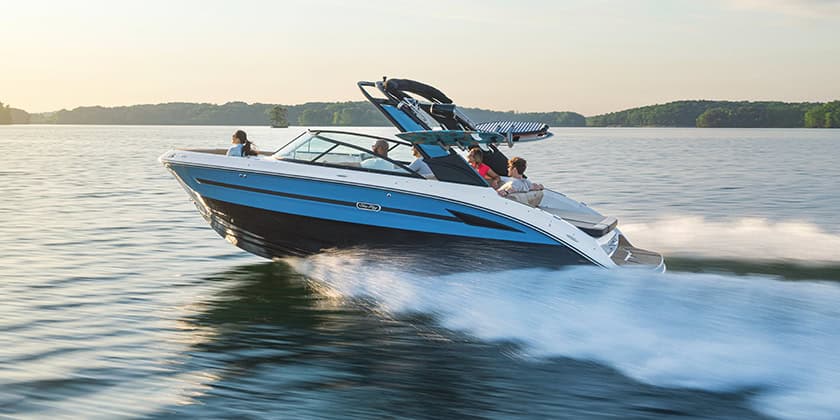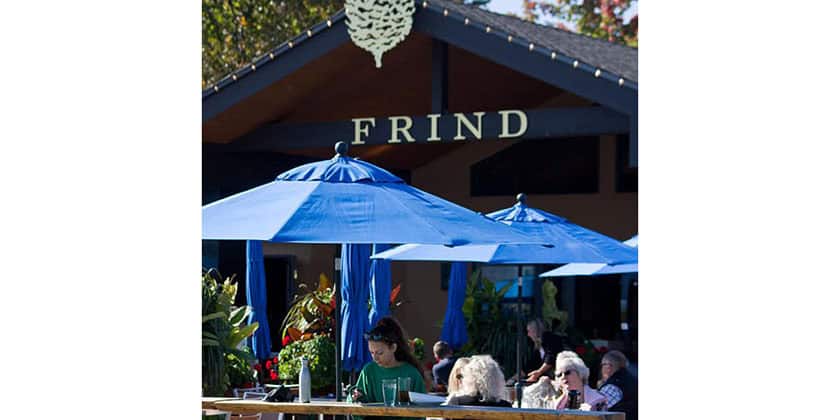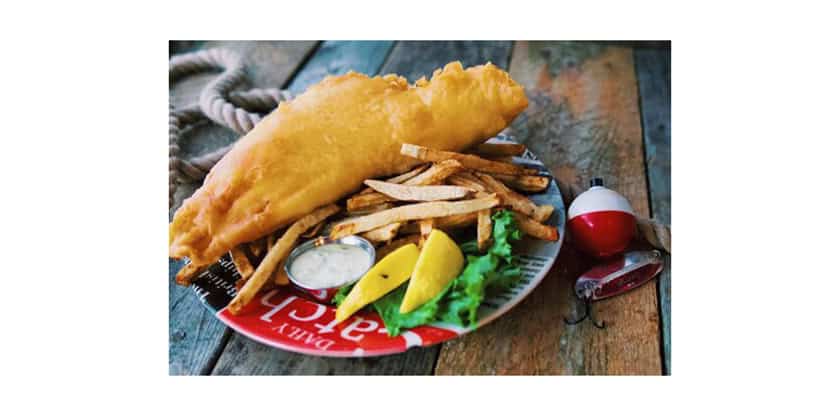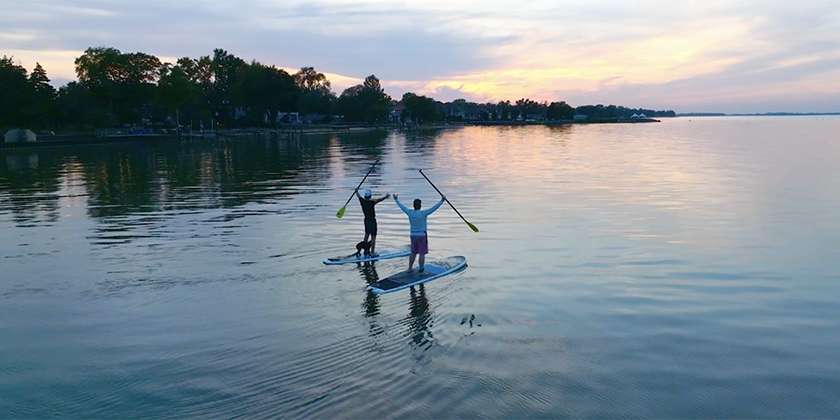Trendsetter 40
Fuel-efficiency with a traditional look
By Doug Dawson
The Trendsetter 40 offers a cross between the contemporary double-cabin cruiser and the fuel-efficient trawler, and proceeds to go one better-it moves out at twice the speed of a trawler, and on less fuel. That may seem an extravagant claim, but the yacht appears quite capable of producing the statistics that compel its builder, Bob Valley of Valley Boatworks in Brampton, Ontario, to proclaim it “North America’s most fuel-efficient 40-foot cruiser.” By Valley’s own calculations, arrived at with a radar gun and a measured fuel container, the Trendsetter bums 4.45 imperial gph while cruising at 16 mph and revving 2,020 rpm.
He gleefully compares those figures with the 7.79 gph a competitor’s 38-foot cruiser consumes while running at the same speed and rewing 2,560 rpm. Valley’s comparisons do not stop there.In a battle of statistics between the Trendsetter 40 and a diesel cruiser and a trawler, the latter pair’s performance figures culled from tests in two American boating magazines, the Trendsetter shone. At 9.7 mph, the Trendsetter burned 30 per cent less fuel than the trawler and 45 per cent less than the cruiser. At 18.5 mph, the Trendsetter achieved better mileage than the trawler at 9.7 knots and demonstrated 45 per cent better mileage than the cruiser.
The Trendsetter 40 is not intended to be the ideal boat for everyone. The people who should give the Trendsetter serious consideration are experienced boaters looking for a long-range, fuel-efficient aft-cabin motor yacht, who want to buy Canadian and who want- to cruise at 18 mph with occasional bursts to 23 mph instead of being handcuffed to the helm at a trawler’s fuel-efficient 10 knots. The Trendsetter 40 was designed by David Martin, who has tackled such familiar names as Egg Harbor, Pacemaker and Ocean Yachts on his drafting board. Since the fuel shortage of 1973, the New Jersey naval architect has perfected hull designs that are more fuel efficient. They achieve more miles per gallon and more speed with the same horsepower.
With the Trendsetter 40, Martin has conjured a magical combination of a relatively narrow beam of 11 feet, two inches for less resistance, a round chine for smooth entry, a full-length skeg for stability, a wide stem for lift and a nearly vertical stem for a longer waterline. Added to this is what Martin calls his new “Ocean Yacht multiple chine bow design, which reduces bow wave resistance by chopping the bow wave off at the lower chine.” This very modern, forward-thinking hull shape is hidden beneath an exterior design and interior accommodations package that may strike some boaters as relatively plain or even a little old-fashioned, but the interior favorably reminded me of the good old days inside a wooden yacht like a Shepherd or a Chris Connie.
Keeping in mind that you, the captain, rarely see your own boat from any other vantage point than the wheel of in the cabin, you’ll have the last laugh on those who scoff at the traditional appearance of you new fuel efficient yacht. The test boat was equipped with a single not twin 235 hp Volvo diesel equipped with a 2.5:1 transmission. Sea trials were conducted on Lake Ontario in a three to four foot ground swell. As I advanced the throttle, the full length of the boat rose out of the water without plowing through the usual bow-high attitude.
The boat planed easily at 1,800 rpm and cruised nicely at 2,250rpm at approximately 18 mph. I moved the throttle to the limit of 2,700rpm, which gave us a considerable top end speed of more than 23mph. Not many single engine diesel yachts are fast enough to pull water skiers and still get the fuel of a trawler. Cruising offshore a few miles for photo runs, I found the boat easy to steer. It tracked straight, even in the following sea. On the run home against seas and wind, the spray from the bottom ran aft below the hulls waterline, making the boat extremely dry. Spray was cascading up and over the 42-foot roamer we were using for photo boat.
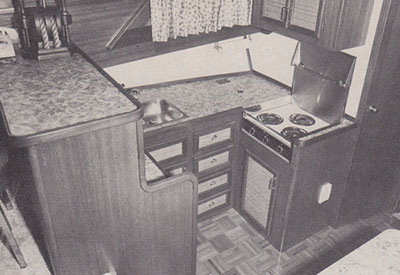 Skeptics are no doubt wondering how a single engine 40 footer handles in harbor. The Trendsetter turns tightly, even against the torque. I backed up about five lengths in a straight line, and found it to track well in reverse both to port and starboard. The test boat equipped with a gigantic 26 inch by 28 inch pro. When I shifted into reverse, there was no doubt that I was in gear unlike some single engine boats in which you feel like breaking out the oars and rowing like crazy to get it to stop. While idling through the harbor at 1,000 rpm, I noticed that there was no wake. The long, narrow hull of the Trendsetter seemed to glide over the top of the water.
Skeptics are no doubt wondering how a single engine 40 footer handles in harbor. The Trendsetter turns tightly, even against the torque. I backed up about five lengths in a straight line, and found it to track well in reverse both to port and starboard. The test boat equipped with a gigantic 26 inch by 28 inch pro. When I shifted into reverse, there was no doubt that I was in gear unlike some single engine boats in which you feel like breaking out the oars and rowing like crazy to get it to stop. While idling through the harbor at 1,000 rpm, I noticed that there was no wake. The long, narrow hull of the Trendsetter seemed to glide over the top of the water.
If you remain unconvinced that a 40-footer can be handled easily with a single engine, you can always order twins or a bow thruster. But test it first. The forward and side decks offers plenty of foot room for handling line. The full length bow rail is high enough to reach yours pockets, with stanchion bases bolted through the deck. The windows on the forward cabin and saloon are secured in hefty stainless steel framing. At first glance, I thought the bridge windshield framing was painted mahogany, but discovered that the entire windshield superstructure is built of permanently finished aluminum no peeling, no painting, no rot. The decks and the cabin superstructure are molded mahogany plywood protected by a thick fiberglass covering.
Even the side windows tracks are fully glassed in so that rain runs along a fiberglass through an out scupper. The wide side deck is simple, with no rides or steps. The deck area over the aft cabin is raised two steps above the side decks. This area is completely enclosed by an extra long convertible top that offers the same shelter as a camper top without the extra bows. Below the stainless steel taffrails white Plexiglas weather boards fit tightly to the deck to keep seas and spray out and small articles in. the side curtains are completely clear, with no areas visibility blocked. The canvas corners held down with snaps on most boats are more neatly secured Velcro.
The helm station is quite small, compared with the massive space age consoles of so many boats today. But with a single engine, there is only one set of gauges, a throttle and s shift lever to accommodate. The wheel is a gorgeous piece of workmanship, a varnished combination of teak and holly. The wind shield offers clear visibility whether you seated in the single pedestal swivel helm seat or standing. Forward of the helm is space for installation of whatever electronic gadgetry you wish. As I descended the stairs into the main saloon, I felt as though I was also going back in time, into a handcrafted mahogany yacht like a 40-foot Pacemaker or a 42 foot Shepherd. The general tone and décor of the entire interior is very traditional. Varnished mahogany boards predominate in the interior, being used in the construction of the cabin sides, cabinets and windshield and bulkhead framing.
The ceiling is like that of an Egg Harbor; the headliner material is held in place with four varnished mahogany battens. The carpet is plush, thick, and neutral gray. All hardware door handles, hinges, lights is brass. Furniture in the test boat included a matching table and stools with brass accents. As in the good old days, all screws are countersunk and plugged. Even the curtain tracks are colour coordinated. We’ll start in the forward stateroom and work our way aft. The stateroom is traditionally laid out, with a V berth, hanging locker and its own door to the forward head. The hull sides and the bulkheads are covered with a white vinyl wall covering, which keeps the stateroom bright yet far from sterile.
The center insert in all the varnished mahogany doors is covered with cane. Decor previously mentioned in the saloon is carried into the forward stateroom, including brass hardware and lamps, and the battened headliner. It was the first time I’ve ever seen a mahogany sea rail curving around the top of the hanging locker as well as the oblique curve in the middle of the V berth. The forward head, being in the port forward corner of the cabin, is lit by both the side and the front windows. The vanity features a large kidney-shaped sink with brass fixtures. Below are two large cane-covered mahogany doors revealing storage space suitable for a long cruise.
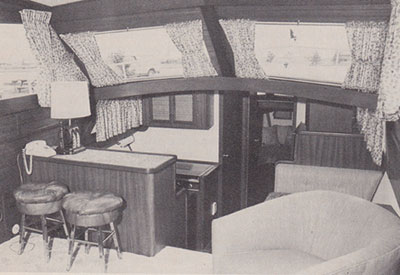 The traditional decor of the rest of the boat fills the head with varnished mahogany and brass hardware. The test boat came equipped with the first teak toilet seat I’ve ever seen. There is a full six feet, three inches of headroom throughout the head and the stateroom. A sensible parquet floor flows without a step from the head out into the galley/ dinette area. In the galley/ dinette area, the oak parquet floor is the first of a long list of sensible ideas. For the serious long-range or live aboard boater, nothing beats a dinette, and here it is large enough for five adults to eat without an elbow landing in the ribs. The table is topped with the same cross-section oak pattern as the galley counter.
The traditional decor of the rest of the boat fills the head with varnished mahogany and brass hardware. The test boat came equipped with the first teak toilet seat I’ve ever seen. There is a full six feet, three inches of headroom throughout the head and the stateroom. A sensible parquet floor flows without a step from the head out into the galley/ dinette area. In the galley/ dinette area, the oak parquet floor is the first of a long list of sensible ideas. For the serious long-range or live aboard boater, nothing beats a dinette, and here it is large enough for five adults to eat without an elbow landing in the ribs. The table is topped with the same cross-section oak pattern as the galley counter.
Varnished mahogany veneer trims the table’s edge. The floor is one level from the galley through to the underside of the dinette, and will be easier to clean than carpet. The galley features a deep, double stainless steel sink, a standard three-burner Princess stove and oven with hardwood top, and a full-height Norcold 12V / 110V fridge with mahogany veneer door. There is enough room left over for your microwave, and more storage space in these two areas than aboard other yachts of this size. Under the hinged lid of the step up to the saloon is additional storage, with the generator controls handy. Moving aft, you find a divider that houses a dry bar.
Under its lid is a rack for glasses and seven round bottles- Bob Valley will happily cut square holes, if you so desire. Another divider, above the galley, has an 18-inch wide top that doubles as a snack bar. The edges of both dividers are trimmed with more curved sea rails-very sensible and stylish. The snack bar in the test boat was furnished with two short stools, just the right height. Around the perimeter of the master stateroom are built-in credenzas and night tables reminiscent of a 40-foot Pacemaker, but these have the color and the finish of the varnished mahogany in an Egg Harbor. Positioned against the transom is a large double bed, mounted low over the water tank.
Most aft stateroom beds are higher because they are mounted over the fuel tanks. Lifting the bedspread reveals an 18-inch-high base with a varnished mahogany plank that curves around the foot of the bed. The curves eliminate those corners that we all too often trip over in the middle of the night. The head of the bed is tight to the transom, utilizing the full length of the hull. Lighting mounted behind the valances casts a soft glow. More curved sea rails border the tops of the lockers and cabinets. A generous quantity of 11 OV outlets are thoughtfully placed throughout. Natural light enters through two relatively large side windows and one transom window that doubles as an emergency exit.
The master stateroom head, to port in the stateroom, features a shower stall with curved corners, a two-piece sliding door and a six-inch-high step to contain the water. The engine room is reached through the middle of the saloon floor. It is high, bright, white and spotless with a big green Volvo engine positioned in the middle. The optional 4.4 -kw Westerbeke generator is mounted to starboard. The optional central vacuum cleaner system and standard hot water tank can be located to port. Aft on both sides are two large fiberglass fuel tanks. I was surprised to see that there was no insulation in the engine room, as the sound level hadn’t noticeably changed during our test from idle to cruise. All the floor framing in the engine room, as well as down the various hatches, is mahogany. When you were younger, did you dream of cruising on a traditional mahogany motor yacht like a Pacemaker, Egg Harbor, Shepherd or Chris-Craft?
Do you now want an efficient diesel trawler for extensive cruises although you aren’t excited about excessive exterior teak, chugging along at nine mph, or flying overseas to visit your dream yacht during construction? I suggest you give the Trendsetter, which is made in Brampton, Ontario, the opportunity of your thorough inspection.
Doug Dawson owns Doug Dawson Yacht Sales. He is an experienced member of the marine industry and a past president of the Ontario Marina Operators Association.
Originally published in Canadian Yachting’s January 1985 issue.
Specifications:
LOA…………….40ft
Waterline……..37ft 11in
Beam…………….11ft 2in
Draft……………..3ft 6in
Power: Single…..235-hp Volvo diesel, option twin
Fuel Capacity……125 U.S. gal
Water Capacity ….100 U.S. gal
Displacement……..19,000lbs
Cruising range……..300n.m.
Base price…………….$155,000 (1985)
Test Boat Price……..$178,000 (1985)










